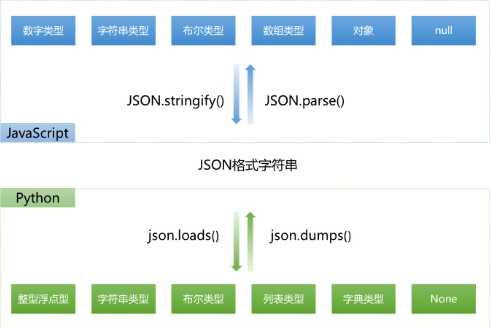标签:请求 客户端 post response 分网 方式 imp img style
* JSON 使用 JavaScript 语法来描述数据对象,但是 JSON 仍然独立于语言和平台。JSON 解析器和 JSON 库支持许多不同的编程语言

正确的json对象:
["one", "two", "three"]
{ "one": 1, "two": 2, "three": 3 }
{"names": ["张三", "李四"] }
[ { "name": "张三"}, {"name": "李四"} ]
不正确的json对象:
{ name: "张三", ‘age‘: 32 } // 属性名必须使用双引号
[32, 64, 128, 0xFFF] // 不能使用十六进制值
{ "name": "张三", "age": undefined } // 不能使用undefined
{ "name": "张三",
"birthday": new Date(‘Fri, 26 Aug 2011 07:13:10 GMT‘),
"getName": function() {return this.name;} // 不能使用函数和日期对象
}
JavaScript中关于JSON对象和字符串转换的两个方法:
JSON.parse(): 用于将一个 JSON 字符串转换为 JavaScript 对象
JSON.parse(‘{"name":"wl"}‘);
JSON.parse(‘{name:"wl"}‘) ; // 错误
JSON.parse(‘[18,undefined]‘) ; // 错误
JSON.stringify(): 用于将 JavaScript 值转换为 JSON 字符串。
JSON.stringify({"name":"wl"})
AJAX(Asynchronous Javascript And XML)翻译成中文就是“异步的Javascript和XML”。即使用Javascript语言与服务器进行异步交互,传输的数据为XML(当然,传输的数据不只是XML)。
AJAX 不是新的编程语言,而是一种使用现有标准的新方法。
AJAX 最大的优点是在不重新加载整个页面的情况下,可以与服务器交换数据并更新部分网页内容。(这一特点给用户的感受是在不知不觉中完成请求和响应过程)
AJAX 不需要任何浏览器插件,但需要用户允许JavaScript在浏览器上执行。
页面输入两个整数,通过AJAX传输到后端计算出结果并返回
views.py代码
from django.shortcuts import render, HttpResponse def index(request): if request.method == ‘POST‘: i1 = request.POST.get(‘i1‘) i2 = request.POST.get(‘i2‘) i3 = int(i1) + int(i2) return render(request, ‘index.html‘, {‘i1‘: i1, ‘i2‘: i2, ‘i3‘: i3}) return render(request, ‘index.html‘) def calc(request): i1 = request.POST.get(‘i1‘) i2 = request.POST.get(‘i2‘) i3 = int(i1) + int(i2) return HttpResponse(i3)
HTML代码
<!DOCTYPE html> <html lang="en"> <head> <meta charset="UTF-8"> <title>Title</title> </head> <body> <input type="text" name="i1">+ <input type="text" name="i2">= <input type="text" name="i3"> <button id="b1">计算</button> <script src="https://cdn.bootcss.com/jquery/3.3.1/jquery.js"></script> <script> $(‘#b1‘).click(function () { $.ajax({ url:‘/calc/‘, type:‘post‘, data:{ i1:$(‘[name="i1"]‘).val(), i2:$(‘[name="i2"]‘).val(), }, success:function (res) { $(‘[name = "i3"]‘).val(res) } }) }) </script> </body> </html>
urls.py
from app01 import views urlpatterns = [ url(r‘^admin/‘, admin.site.urls), url(r‘^index/‘, views.index), url(r‘^calc/‘, views.calc), ]
参数
$.ajax({ url: ‘/ajax_test/‘, # 提交的地址 type: ‘post‘, # 提交的方式 data: { # 数据 name: ‘alex‘, age: 73, hobby: JSON.stringify([‘大保健‘, ‘cnb‘, ‘画大饼‘]) #提交多个数据 }, success: function (res) { # 回调函数 $(‘[name="ii3"]‘).val(res) }, error: function (res) { #错误 console.log(res) } }) #views import json def ajax_test(request): print(request.POST) # hobby = request.POST.getlist(‘hobby[]‘) hobby = request.POST.get(‘hobby‘) hobby = json.loads(hobby) print(hobby, type(hobby)) # int(‘a‘) return HttpResponse(‘OK‘)
urls.py
from app01 import views urlpatterns = [ url(r‘^admin/‘, admin.site.urls), url(r‘^index/‘, views.index), url(r‘^calc/‘, views.calc), url(r‘^upload/‘, views.upload), ]
upload.html
<!DOCTYPE html> <html lang="en"> <head> <meta charset="UTF-8"> <title>Title</title> </head> <body> <input type="file" id="f1"> <button id="b1">上传</button> <script src="https://cdn.bootcss.com/jquery/3.3.1/jquery.js"></script> <script> $(‘#b1‘).click(function () { var form_obj = new FormData(); #组建FormData对象 form_obj.append(‘x1‘,$(‘#f1‘)[0].files[0]) $.ajax({ url:‘/upload/‘, type : ‘post‘, data: form_obj, processData:false, # 不处理编码方式 contentType:false, #不处理contentType请求头 success:function (res) { alert(‘ok‘) } }) }) </script> </body>
views.py
def upload(requset): if requset.is_ajax(): file_obj = requset.FILES.get(‘x1‘) with open(file_obj.name,‘wb‘) as f: for i in file_obj.chunks(): f.write(i) return render(requset,‘upload.html‘)
一.模板中使用csrf_token 标签
<!DOCTYPE html> <html lang="en"> <head> <meta charset="UTF-8"> <title>Title</title> </head> <body> <input type="text" name="i1">+ <input type="text" name="i2">= <input type="text" name="i3"> <button id="b1">计算</button> <script src="https://cdn.bootcss.com/jquery/3.3.1/jquery.js"></script> {% csrf_token %} <script> $(‘#b1‘).click(function () { $.ajax({ url:‘/calc/‘, type:‘post‘, data:{ csrfmiddlewaretoken: $(‘[name="csrfmiddlewaretoken"]‘).val(), i1:$(‘[name="i1"]‘).val(), i2:$(‘[name="i2"]‘).val(), }, success:function (res) { $(‘[name = "i3"]‘).val(res) } }) }) </script> </body> </html>
二.获取请求头
<!DOCTYPE html> <html lang="en"> <head> <meta charset="UTF-8"> <title>Title</title> </head> <body> <input type="text" name="i1">+ <input type="text" name="i2">= <input type="text" name="i3"> <button id="b1">计算</button> <script src="https://cdn.bootcss.com/jquery/3.3.1/jquery.js"></script> {% csrf_token %} <script> $(‘#b1‘).click(function () { $.ajax({ url:‘/calc/‘, type:‘post‘, headers:{ ‘X-csrftoken‘: $(‘[name="csrfmiddlewaretoken"]‘).val(), }, data:{ i1:$(‘[name="i1"]‘).val(), i2:$(‘[name="i2"]‘).val(), }, success:function (res) { $(‘[name = "i3"]‘).val(res) } }) }) </script> </body> </html>
三.文件(常用)

function getCookie(name) { var cookieValue = null; if (document.cookie && document.cookie !== ‘‘) { var cookies = document.cookie.split(‘;‘); for (var i = 0; i < cookies.length; i++) { var cookie = jQuery.trim(cookies[i]); // Does this cookie string begin with the name we want? if (cookie.substring(0, name.length + 1) === (name + ‘=‘)) { cookieValue = decodeURIComponent(cookie.substring(name.length + 1)); break; } } } return cookieValue; } var csrftoken = getCookie(‘csrftoken‘); function csrfSafeMethod(method) { // these HTTP methods do not require CSRF protection return (/^(GET|HEAD|OPTIONS|TRACE)$/.test(method)); } $.ajaxSetup({ beforeSend: function (xhr, settings) { if (!csrfSafeMethod(settings.type) && !this.crossDomain) { xhr.setRequestHeader("X-CSRFToken", csrftoken); } } });
settings.py 静态文件配置
STATICFILES_DIRS = [ os.path.join(BASE_DIR,‘static‘) ]
模板
<!DOCTYPE html> <html lang="en"> <head> <meta charset="UTF-8"> <title>Title</title> </head> <body> <input type="text" name="i1">+ <input type="text" name="i2">= <input type="text" name="i3"> <button id="b1">计算</button> <script src="https://cdn.bootcss.com/jquery/3.3.1/jquery.js"></script> <script src="/static/js/ajax_setup.js"></script> <script> $(‘#b1‘).click(function () { $.ajax({ url:‘/calc/‘, type:‘post‘, data:{ i1:$(‘[name="i1"]‘).val(), i2:$(‘[name="i2"]‘).val(), }, success:function (res) { $(‘[name = "i3"]‘).val(res) } }) }) </script> </body> </html>
标签:请求 客户端 post response 分网 方式 imp img style
原文地址:https://www.cnblogs.com/wanglan/p/10381396.html